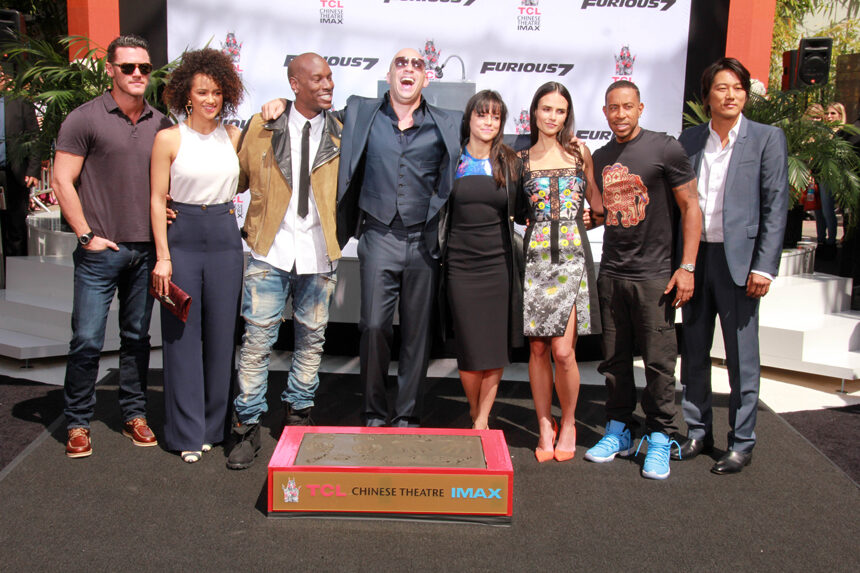Ask anyone who works in entertainment and they will tell you that the crown jewel of any studio is the franchise. From Yellowstone to Law & Order, from NCIS to the MCU, the terrain is dotted with sprawling sagas that occupy multiple nights of television, stretch across streaming services, or have theatrical opening dates staked out years in advance. Some successes seem almost preordained, but other franchises have emerged from very unlikely places. From cancelled TV shows to comic book parodies to the real-life tale of a wrestler turned sheriff, here are ten of the most unlikely franchises in entertainment history.
1. Walking Tall
The original Walking Tall trailer (Uploaded to YouTube by Shout! Factory)
Fifty years ago this week, Walking Tall hit theaters like a big, wooden club. Which is appropriate, because that was one of the preferred weapons of Sheriff Buford Pusser, a real-life lawman played by Joe Don Baker in the movie. The real 6’6” Marine became a professional wrestler after serving; he eventually went home to Tennessee and was elected sheriff. Pusser came into conflict with the State Line Mob and Dixie Mafia outfits, busting up gambling dens and illegal liquor operations. A frequent target of assassins, Pusser lost his wife to one such attempt in 1967. The story drew nationwide attention, paving the way for the film. Made for $500,000, the movie pulled in $10 million in the U.S. and Canada and an addition $30 million worldwide. Two theatrical sequels followed. Walking Tall made the jump to TV movies in 1979, then became a series in 1981. In 2004, Dwayne “The Rock” Johnson headlined a new big budget version that was followed by two direct-to-video films starring Kevin Sorbo.
2. Fast & Furious
Fast X trailer (Uploaded to YouTube by The Fast Saga)
It may sound crazy to insinuate that the incredibly successful street-racing-turned-heist-series Fast & Furious franchise was unlikely, but for a few years before its biggest successes, its continuation was uncertain. 2001’s The Fast and the Furious starred Vin Diesel and Paul Walker; it was a solid hit, earning over $200 million on a $38 million budget and selling just over 2 million copies of the DVD on its release date. However, Diesel declined to return for the sequel, 2 Fast 2 Furious; nevertheless, the film performed better than the first, but against a larger budget. By 2006’s The Fast and the Furious: Tokyo Drift, Walker stepped out, Diesel made a cameo, and the movie’s performance suffered against an increasingly larger budget. It would have been understandable for the franchise to simply wrap at that point.
However, Diesel’s reappearance energized fans, and there was enough buzz about a possible return that Tokyo Drift director Justin Lin returned with Diesel, Walker, and fellow stars Jordana Brewster and Michelle Rodriguez in tow for 2009’s Fast and Furious. Gal Gadot made her franchise debut as well. The movie was a major hit, but the whole thing was just getting warmed up. 2011’s Fast Five was the Avengers of the franchise, bringing together ten actors from the previous four films, plus Dwayne “The Rock” Johnson, and shifting the emphasis from racing to international heists and action. The movie was a monster hit that’s widely considered one of the best in the franchise by both critics and fans (Roger Ebert praised it, saying the film was “made of sheer, preposterous and nonstop impossible action”). Since then, there have been four more direct sequels, a spin-off for Johnson and Jason Statham (Hobbs & Shaw), and a tenth installment due in May.
3. Star Trek
Star Trek (2009) trailer (Uploaded to YouTube by Rotten Tomatoes Classic Trailers)
Let’s jump through the Guardian of Forever to February 1969. Season 3 of the TV show Star Trek wrapped filming a month earlier, and though aletter-writing campaign had gotten fans one more season, word came down that Star Trek was cancelled. For four years, there was no Star Trek. From 1973 to 1974, a brief animated version appeared. However, a combination of factors — including the possibility of Paramount creating a fourth network and the success of 1977’s Star Wars igniting new interest in science fiction — led Trek creator Gene Roddenberry to begin work on a new series. Dubbed Star Trek: Phase II, it was to be the flagship of the aborning Paramount network. However, the network never launched and the studio decided that Trek should head to the big screen. Star Trek: The Motion Picture arrived in 1979 and set a successful film franchise in motion, but didn’t stop there. Trek returned to TV in 1987 with the hugely popular Star Trek: The Next Generation. Since its return, Trek has spawned 13 feature films, seven additional live-action series, three animated series, a series of shorts, theme park attractions, collectibles, and hundreds of novels and comics. . Not bad for a show that was cancelled over 50 years ago.
4. Hannibal Lecter
Silence of the Lambs trailer (Uploaded to YouTube by Rotten Tomatoes Classic Trailers)
It might be hard for people to imagine now, but “Hannibal the Cannibal” wasn’t even the main character of Red Dragon, his first literary outing. Thomas Harris’s 1981 novel made it to the screen as Manhunter, stylishly directed by Michael Mann. In that film, Brian Cox played the killer that advises FBI Special Agent Will Graham (William Petersen). Lecter returned the screen in 1991’s The Silence of the Lambs (adapting Harris’s 1988 novel), this time in the form of Anthony Hopkins. The film became something of a pop-culture phenomenon, finishing fifth at the box office for the year. At the Oscars, it pulled off a rare sweep, taking Best Picture, Best Actor (Hopkins), Best Actress (Jodie Foster), Best Adapted Screenplay (Ted Tally), and Best Director (Jonathan Demme). Over the years, Harris wrote two further novels (Hannibal and Hannibal Rising, which is a prequel with a young Lecter), which were both adapted; Red Dragon got a remake in 2002 to give Hopkins a chance to play Lecter in all three adaptations where he was an adult. There have also been two TV projects: the widely acclaimed Hannibal, which ran from 2013 to 2015, and Clarice, a one-season show from 2021 that focused on agent Clarice Starling (though only passing, oblique references were made to Lecter). As far as franchise leads go, whoever had “Psychiatrist turned Cannibal Serial Killer” on their Bingo card was a big winner.
5. Rambo
First Blood 40th anniversary trailer (Uploaded to YouTube by Lionsgate Movies)
A franchise isn’t very likely when the main character dies at the end of the novel in which they debuted. That’s what happened with Rambo, whose first name wasn’t revealed in the pagesof 1972’s First Blood. Writer David Morrell sold the film rights soon after and watched as the book bounced around multiple studios and 18 screenplay passes over the next decade. First Blood finally hit screens in 1982 with Sylvester Stallone as Rambo. However, Stallone flexed (no pun intended) his stardom and wrought a number of changes, the most significant of which was that Rambo lived. With the film a major success and a sequel assured, Morrell shrugged and knocked out a novelization for Rambo: First Blood Part II because, hey, Rambo was a hit. Stallone played the character across five films made between 1982 and 2019. Weirdly enough, there was also a Rambo cartoon in 1986. Rambo has also been an extremely popular video game character, taking the lead in seven games and appearing as an extra or unlockable character in another eight.
6. Teenage Mutant Ninja Turtles
Teenage Mutant Ninja Turtles (2014) trailer (Uploaded to YouTube by Rotten Tomatoes Trailers)
Parodies aren’t unusual in any field of art, but parodies that become pop culture monoliths unto themselves are much rarer. In 1983, Kevin Eastman and Peter Laird were artists and roommates. That November, Eastman sketched a turtle with nunchucks, a sort of homage to funny animal comics like Howard the Duck and the ninja storylines that had exploded in popularity in Frank Miller’s run on Daredevil. Laird wrote in “teenage mutant” above the picture, riffing on the top-selling comic of the day, Uncanny X-Men. Soon enough, the two creators had put together a team of four teenage mutant ninja turtles and their rat sensei. Sensing possibility, the pair pooled a loan from Eastman’s uncle and tax refund checks to found Mirage Studios and put out a black-and-white first issue in 1984. The first printing sold out, and the pair had an indie comic hit on their hands. By 1987, Eastman and Laird had a toy deal with Playmates Toys, and that led to an animated series. There was no looking back. To date, there have been five TV series, six theatrical films (with a seventh coming this year), an avalanche of comics, insanely popular arcade and video games, and hundreds and hundreds of toys (Playmates produced more than 400 action figures in their first decade). Turtle Power indeed.
7. The Walking Dead
The Walking Dead Season One trailer (Uploaded to YouTube by Trailer Blend)
Zombies have been perennially popular in horror circles for decades — particularly since George A. Romero and John Russo reinvented the rules with 1968’s Night of the Living Dead — but they had never led to entire TV universes before. Writer Robert Kirkman and artist Tony Moore launched their parody comic, Battle Pope, in 2000. That led to work at Image Comics and opened the door for Kirkman and artist Cory Walker to create the super-hero series Invincible. With that series established, Kirkman and Moore started working on their concept for a black-and-white zombie series influenced by Romero. Image was initially reluctant to jump on the zombie bandwagon until Kirkman fabricated the notion that it would be part of an alien plot. Given the greenlight, the duo launched The Walking Dead in 2003. The first few issues had small print runs but were immediate sell-outs. Moore left after six issues, and Charlie Adlard took over on art. As the readership swelled with each issue, the book became an extremely popular series that was frequently nominated for awards (winning the Eisner, essentially the Oscar of comics, for Best Continuing Series in 2007 and 2010). But the launch of The Walking Dead TV series on AMC in 2010 marked a massive level-up. A major worldwide hit, the TV series has yielded multiple spin-offs, web series, video games, novels, and additional comics. Though Kirkman brought the original run comic to an end with issue #193 in 2019 and the first TV series concluded last year, color reprints of the comic continue and three more TV continuations are in the offing.
8. The Karate Kid
Official Cobra Kai Season One trailer (Uploaded to YouTube by Cobra Kai)
A teenage karate spin on Rocky (by that film’s director, John G. Avildsen, no less) might have seemed like a solid hit in 1984. However, The Karate Kid exceeded all expectations, pulling in $130 million on an $8 million budget and netting Academy Award and Golden Globe nominations for Pat Morita’s indelible performance as Mr. Miyagi. Two more sequels with Morita and the titular kid, Daniel LaRusso (Ralph Macchio) followed, as well as a brief 1989 animated series; Macchio exited the films and a young Hilary Swank took over in 1994’s The Next Karate Kid. That film fared poorly, and the series wasn’t revisited until a 2010 reboot with Jackie Chan and Jaden Smith. The reboot was a big success, but for various reasons, a sequel floundered.
Then, a completely improbable turnaround based on recurring pop culture jokes happened. Through various projects (a music video here, a Funny or Die video there), Macchio and his original antagonist William Zabka (who played Johnny) began parodying their Karate Kid personas. Zabka would mention in interviews that he saw Johnny as the good guy. That thread was played out in a running bit on CBS sitcom How I Met Your Mother, which saw both actors appear and extend that gag. That influenced Josh Heald, Jon Hurwitz, and Hayden Schlossberg, who teamed up to create the streaming series Cobra Kai. Launching on YouTube Red in 2018, the show positioned Johnny as more of the protagonist and was driven by comedy and over-the-top action. After the second season, Netflix acquired the show and it blew up, even receiving an Emmy nomination for Outstanding Comedy Series for season three. At present, a sixth and final season is planned, followed by the franchise’s return to movie theaters (though if Cobra Kai will connect to the new film is the subject of ongoing debate).
9. Saw
Saw (2004) trailer (Uploaded to YouTube by Rotten Tomatoes Classic Trailers)
Okay, we’ll admit it: there is nothing at all improbable about a horror franchise; they’ve been a layer of Hollywood’s bedrock since the 1930s when Frankenstein, Dracula, and the gang pumped out multiple installments for Universal. But 2004’s Saw was different. Not only did it generate a franchise out of a somewhat bonkers premise, it made the careers of two guys who have completely elevated a number of franchises and the entire horror genre in the years since. It all started when the Australian duo of director James Wan and writer/actor Leigh Whannell finished film school and decided to put a low-budget film together. They wanted to constrict it to one location, and Wan came up with the notion of two men trapped in a room with a body on the floor; Whannell almost instantly came up with the title based on one crucial story element, while the inspiration for Jigsaw came during a doctor’s appointment. After making a seven-minute proof-of-concept short film, the pair nabbed a deal in Hollywood and got a budget of just over $1 million to make their movie. It would make 100 times that.
While critics were split, Saw struck a note with audiences for its ingenious traps and all-timer of a final twist. The success of the first film launched the Saw franchise (nine movies and counting, with Saw X due in October). However, Saw also catapulted Wan and Whannell into positions where they could do much more work. The pair created the Insidious franchise and Wan directed the first two installments of The Conjuring series, which led to an eight-films-and-counting Conjuring universe (itself an unlikely franchise, inspired by Ed and Lorraine Warren). Whannell also wrote and directed Upgrade (sequel pending), the critically acclaimed The Invisible Man reboot (sequel pending), and will be leading a reboot of John Carpenter’s dystopian sci-fi classic, Escape from New York. Wan also branched out of horror, directing Furious 7 and both Aquaman films, but keeps a foot in scares with films like Malignant and M3GAN. So even if you could guess that Saw could be a big franchise, it would have been much harder to predict how many modern horror (and beyond) hits run back to Wan and Whannell.
10. Pirates of the Caribbean
Pirates of the Caribbean: Curse of the Black Pearl trailer (Uploaded to YouTube by Rotten Tomatoes Classic Trailers)
Isn’t it obvious? It’s improbable because it was a theme park ride — a theme park ride that opened in 1967! Disney decided to take a swing at making it into a 2003 movie. Five installments and $4.5 billion later, it’s presently the 16th highest grossing film series of all time. It would probably not shock you in the slightest that a sixth one is on the way.
Become a Saturday Evening Post member and enjoy unlimited access. Subscribe now



